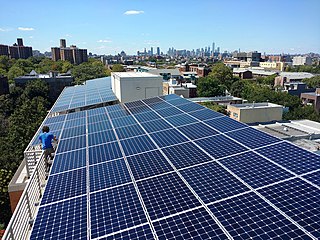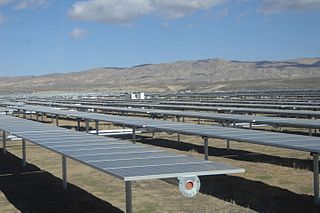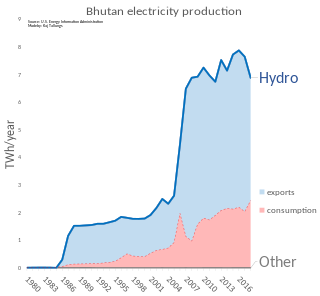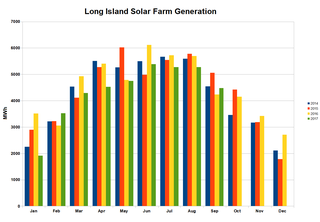
Iberdrola, S.A. is a Spanish multinational electric utility company based in Bilbao, Spain. It has around 40,000 employees and serves around 30 million customers.

Many countries and territories have installed significant solar power capacity into their electrical grids to supplement or provide an alternative to conventional energy sources. Solar power plants use one of two technologies:

Solar power has a small but growing role in electricity production in the United Kingdom.

Solar power includes solar farms as well as local distributed generation, mostly on rooftops and increasingly from community solar arrays. In 2023, utility-scale solar power generated 164.5 terawatt-hours (TWh), or 3.9% of electricity in the United States. Total solar generation that year, including estimated small-scale photovoltaic generation, was 238 TWh.

Topaz Solar Farm is a 550 megawatt (MWAC) photovoltaic power station in San Luis Obispo County, California, United States. Construction on the project began in November 2011 and ended in November 2014. It is one of the world's largest solar farms. The $2.5 billion project includes 9 million CdTe photovoltaic modules based on thin-film technology, manufactured by U.S. company First Solar. The company also built, operates and maintains the project for MidAmerican Renewables, a Berkshire Hathaway company. Pacific Gas and Electric will buy the electricity under a 25-year power purchase agreement. According to First Solar, it created about 400 construction jobs.

The California Valley Solar Ranch (CVSR) is a 250 megawatt (MWAC) photovoltaic power plant in the Carrizo Plain, northeast of California Valley. The project is owned by NRG Energy, and SunPower is the EPC contractor and technology provider. The project constructed on 1,966 acres (796 ha) of a 4,365-acre (1,766 ha) site of former grazing land. It is utilizing high-efficiency, crystalline PV panels designed and manufactured by SunPower. The project includes up to 88,000 SunPower solar tracking devices to hold PV panels that track the sun across the sky.

Solar power in Arizona has the potential to, according to then-Governor Janet Napolitano, make Arizona "the Persian Gulf of solar energy". In 2012, Arizona had 1,106 MW of photovoltaic (PV) solar power systems, and 6 MW of concentrated solar power (CSP), bringing the total to over 1,112 megawatts (MW) of solar power. As an example, the Solana Generating Station, a 280 MW parabolic trough solar plant, when commissioned in 2013, was the largest parabolic trough plant in the world and the first U.S. solar plant with molten salt thermal energy storage.

Energy in Croatia describes energy and electricity production, consumption and import in Croatia.

The energy sector in Hawaii has rapidly adopted solar power due to the high costs of electricity, and good solar resources, and has one of the highest per capita rates of solar power in the United States. Hawaii's imported energy costs, mostly for imported petroleum and coal, are three to four times higher than the mainland, so Hawaii has motivation to become one of the highest users of solar energy. Hawaii was the first state in the United States to reach grid parity for photovoltaics. Its tropical location provides abundant ambient energy.

Enel Green Power S.p.A. is an Italian multinational renewable energy corporation, headquartered in Rome. The company was formed as a subsidiary of the power generation firm Enel in December 2008. It has operations in five continents generating energy from solar, geothermal, wind and hydropower sources. As of 2024, it manages a capacity of 64,7 GW, with an annual production of 114.22 TWh and has over 1300 plants worldwide.

Energy in Bhutan has been a primary focus of development in the kingdom under its Five-Year Plans. In cooperation with India, Bhutan has undertaken several hydroelectric projects whose output is traded between the countries. Though Bhutan's many hydroelectric plants provide energy far in excess of its needs in the summer, dry winters and increased fuel demand makes the kingdom a marginal net importer of energy from India.

The 32 megawatt AC Long Island Solar Farm (LISF), located in Upton, New York, was the largest photovoltaic array in the eastern U.S. in November 2011. The LISF is made up of 164,312 solar panels from BP Solar which provide enough electricity for roughly 4,500 households. The project will cause the abatement of more than 30,000 metric tons of carbon dioxide emissions per year. LISF is co-owned by BP Solar and MetLife through Long Island Solar Farm LLC. Municipal utility Long Island Power Authority (LIPA) buys the 37-megawatt (49,600 hp) power plant's output, which is estimated at 44 GWh annually, under a 20-year power purchase agreement (PPA). Payments over that time are expected to total $298 million. The project was engineered by Blue Oak Energy and construction subcontracted to Hawkeye LLC from Hauppauge, New York. The plant earned the Best Photovoltaic Project of Year Award from the New York Solar Energy Industries Association. The panels are mounted at a fixed tilt angle of 35°, with the rows spaced approximately 18 ft 4 in (5.59 m) apart.

Solar power in Saudi Arabia has become more important to the country as oil prices have risen. Saudi Arabia is located in the Arabian Peninsula, where it receives 12 hours of sun a day. Saudi Arabia has the potential to supply its electrical needs solely with solar power. As the largest oil producer and exporter in the world and one of the largest carbon dioxide producers Saudi Arabia would set an important precedent in renewable energy by shifting to solar power. In 2021, 60.89% of energy consumed was produced by burning oil. The Saudi agency in charge of developing the nations renewable energy sector, Ka-care, announced in May 2012 that the nation would install 41 gigawatts (GW) of solar capacity by 2032. It was projected to be composed of 25 GW of solar thermal, and 16 GW of photovoltaics. At the time of this announcement, Saudi Arabia had only 0.003 gigawatts of installed solar energy capacity. A total of 54 GW was expected by 2032, and 24 GW was expected in 2020, which was never reached. 1,100 megawatts (MW) of photovoltaics and 900 megawatts of concentrated solar thermal (CSP) was expected to be completed by early 2013. Also in 2013, solar power in Saudi Arabia had achieved grid parity and was able to produce electricity at costs comparable to conventional sources.
Solar power in Chile is an increasingly important source of energy. Total installed photovoltaic (PV) capacity in Chile reached 8.36 GW in 2023. Solar energy provided 19.9% of national electricity generation in Chile in 2023, compared to less than 0.1% in 2013.
Renewable energy in Bhutan is the use of renewable energy for electricity generation in Bhutan. The renewable energy sources include hydropower.
The Ukujima Mega Solar Plant project in Japan will be one of the world's largest photovoltaic power generation facilities at 480 MW(DC) and 400 MW(AC) respectively.

While being a major oil producing country, the United Arab Emirates (UAE) has taken steps to introduce solar power on a large scale. However, solar power still accounts for a small share of energy production in the country. The country was the 6th top carbon dioxide emitter per capita in the world in 2009, with 40.31 tonnes, but is planning to generate half of its electrical energy by 2050 from solar and nuclear sources, targeting 44% renewables, 38% gas, 12% coal, and 6% nuclear energy sources.
Ultra Mega Solar Power Projects, also known as Ultra Mega Solar Parks, are a series of solar power projects planned by the Ministry of New and Renewable Energy of the Union Government of India. Each power project has a minimum capacity of 500 MW.
The Bwengu Solar Power Station is a 50 megawatts solar power plant, under construction in Malawi. The power station is under development by a consortium led by Quantel Renewable Energy, an independent power producer (IPP), based in the United States. Construction began in February 2022, with commercial commissioning expected in the first quarter of 2023. The energy generated at this solar farm is expected to be sold to the Electricity Supply Corporation of Malawi (ESCOM), under a long-term power purchase agreement (PPA).














